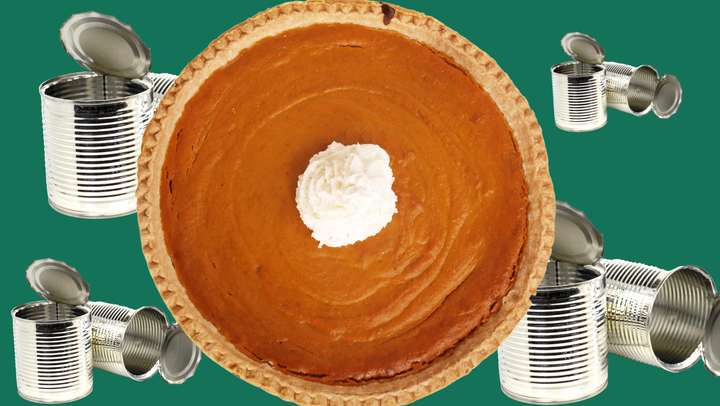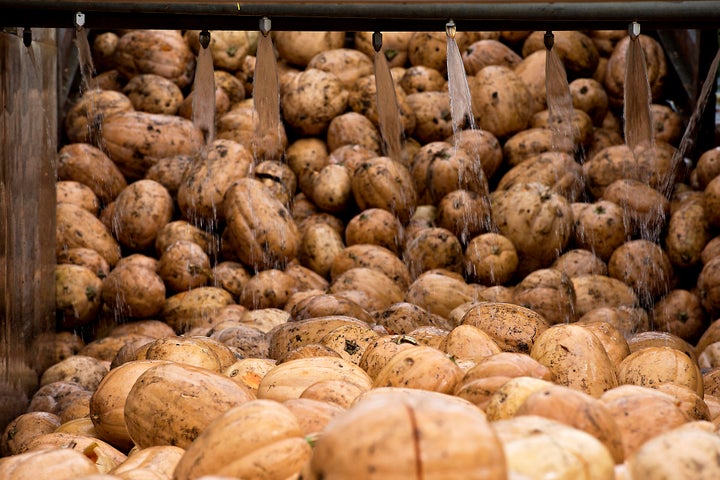
Is canned pumpkin a lie?
Even though a label may read “100% pumpkin,” some argue this isn’t quite the case. It’s debated that there may be something other than just pumpkin in the can — and we’re not talking about ingredients to enhance its taste and texture. While you may be imagining that canned pumpkin is made from a Halloween-shaped pumpkin, it’s rumored that your canned pumpkin may actually contain something more akin to butternut squash. So what’s really in there?
There is actually pumpkin in canned pumpkin.
Yes, there is pumpkin in canned pumpkin. But there’s also squash. Why? Because all pumpkins are squash.
Pumpkins, squash and gourds are all part of the Cucurbita family, which encompasses about 975 species of plants. Since the term “pumpkin” doesn’t have any botanical meaning, it’s considered squash. The Cucurbita family has many varieties with various flavors and textures. Canned pumpkin has been packed from certain types of firm-shelled, golden-fleshed and sweet squash for years.
While pumpkins are squash, any hard-skinned squash can be considered a pumpkin since there isn’t a specific distinction when it comes to what defines a pumpkin.
The reason some people believe canned pumpkin is made sans pumpkin may come down to a pretty lenient description offered by the United States Department of Agriculture in 1957: “Canned pumpkin and canned squash is the canned product prepared from clean, sound, properly matured, golden fleshed, firm shelled, sweet varieties of either pumpkins or squashes by washing, stemming, cutting, steaming and reducing to a pulp.”
In 1988, the Food and Drug Administration issued a ruling that impacts how brands label their canned pumpkin today. It states, “Since 1938, we have consistently advised canners that we would not initiate regulatory action solely because of their using the designation ‘pumpkin’ or ‘canned pumpkin’ on labels for articles prepared from golden-fleshed, sweet squash, or mixtures of such squash with field pumpkins. In the absence of any evidence that this designation misleads or deceives consumers, we see no reason to change this policy.”
The line between pumpkin and squash is blurry, so some squash are referred to as both. So if you say that canned pumpkin is made with squash, and your mom says it’s made with pumpkin, you can both be 100% right.

Most canned pumpkin is made with the Dickinson pumpkin.
Canned pumpkin most likely contains no amount of the quintessential, bright orange jack o’lantern pumpkin many of us imagine when thinking of pumpkins. In fact, they aren’t very tasty at all.
“All pumpkins, including the Dickinson pumpkin Libby’s uses, are a variety of squash belonging to the Cucurbitaceae family or gourd family,” said Eduardo Vivas, senior manager of brand marketing for Libby’s.
A Dickinson pumpkin, often referred to as a Dickinson squash, has a beige exterior and lacks the deep ribbing of the round, orange pumpkins you may carve around Halloween. They are usually larger in size but are more of an oblong shape, with outer rind coloring similar to the butternut squash. They’re preferred when baking and cooking because of their creamy texture.
Most canned pumpkin you’ll find in your local grocery store (including Libby’s and Nestle) is made with the Dickinson pumpkin. But it’s common for some canned pumpkin brands to mix other types of winter squash, like butternut or hubbard, with the Dickinson pumpkin.
Libby’s uses the Dickinson pumpkin in their canned pumpkin — labeling it as containing 100% pumpkin. Vivias said it’s because “they’re exactly the right taste and texture.”
So ... canned pumpkin is made with pumpkin. Or squash.
If the can of pumpkin you purchased says 100% pumpkin, it surely is pumpkin, likely not the orange one you’ve picked at a pumpkin patch. At the end of the day, the distinction between squash and pumpkin is what you choose to call them.